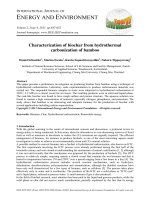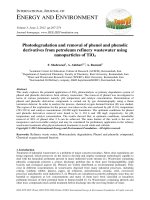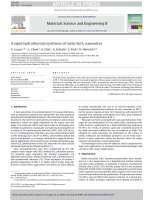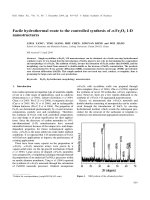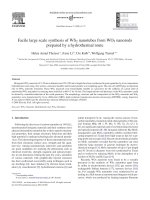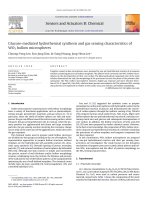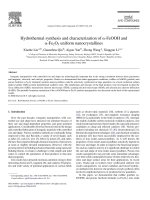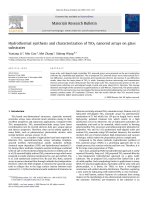- Trang chủ >>
- Khoa Học Tự Nhiên >>
- Vật lý
hydrothermal synthesis of tio2 nanofibres
Bạn đang xem bản rút gọn của tài liệu. Xem và tải ngay bản đầy đủ của tài liệu tại đây (290.04 KB, 3 trang )
Hydrothermal synthesis of TiO
2
nanofibres
Fei-Bao Zhang, Hu-Lin Li
⁎
College of Chemistry and Chemical Engineering, Lanzhou University, Lanzhou 730000, P.R. China
Received 29 November 2005; received in revised form 11 January 2006; accepted 5 February 2006
Available online 20 March 2006
Abstract
TiO
2
nanofibres were synthesized by the hydrothermal method. The result shows that the growth of TiO
2
nanofibres is sensitive to the
concentration of NaOH and the heating temperature.
© 2006 Elsevier B.V. All rights reserved.
Keywords: Nanofibres; Transmission electron microscopy; X-ray diffraction
1. Introduction
Investigation on T iO
2
has been attracting worldwide interest
during the past decades [1–3] for its promising application in l ight
emission, gas sensors, catalyst and solar cells. Low dimensional
nanostructures materials have shown many advantages. Low di-
mensional CdSe nanoro ds have been reported to be better in sola r
energy conv ersion for their single -crystal structures can supply a
directed path for electron transport [4]. A more than 2-fold increase
in maximum photoconversion efficiency for water splitting has
been observed b y replacing TiO
2
nanocrystalline f ilms with T iO
2
nanowires [5]. Thus designing novel TiO
2
nanostructures,
especially well-defined anisotropic and low dimensiona l nanos-
tructures, is of significant impor tance f or fundamental r esearch a s
well as va rio us relevant applications.Uptonow,differentmethods
have been used to sy nthesize the low dimensional TiO
2
.Growthof
1-D TiO
2
nanostructures, including nanowires and nano tubes, has
been demonstrated using sol–gel, electrodeposition, and hydro-
thermal methods with or without a nodic a luminum o xide (AAO)
[6–9].TiO
2
nanorods have also been grown on a WC-Co substrate
by metalorganic chemical vapor deposition ( MOCVD) using t ita-
nium-tetraisopropoxide (TTIP) as the precursor [10].
In this paper, we report a novel strategy to synthesize TiO
2
nanofibres under hydrothermal conditions in alkaline solution.
Compared with the other reporters who use hydrothermal me-
thod to synthesize TiO
2
, the reaction temperature we used was
higher while the concentration of NaOH was lower. To our
knowledge, there are few reports about synthesizing TiO
2
na-
nofibres based on the hydrothermal method. This method may
open a new door to synthesize novel morphology via changing
some conditions.
2. Experimental
The titanium dioxide (TiO
2
, anatase) and sodium hydroxide
(NaOH) are obtained as analysis pure grade and used without
Materials Science and Engineering C 27 (2007) 80– 82
www.elsevier.com/locate/msec
⁎
Corresponding author. Tel.: +86 931 891 2517; fax: +86 931 891 2582.
E-mail address: (H L. Li).
0 1020304050607080 9
0
2
θ
/degree
(2 1 1)
(1 0 5)
(2 0 0)
(0 0 4)
(1 0 0)
Fig. 1. XRD patterns for the sample.
0928-4931/$ - see front matter © 2006 Elsevier B.V. All rights reserved.
doi:10.1016/j.msec.2006.02.001
further purification and treatment. TiO
2
nanofibres were
synthesized in a typical procedure. 0.2 g TiO
2
(anatase)
powder was put into a Teflon-lined stainless steel autoclave of
30 ml capacity. The autoclave was filled with 1 M NaOH
solutions up to 80% of its capacity, maintained at 160 °C for
24 h, and then cooled to room temperature naturally. A white
precipitation was filtered and washed with distilled water and
absolute ethanol in sequence. Finally, the products were dried
at 50 °C. The structure and morphology of products were
characterized by several techniques. Powder X-ray diffraction
(XRD) data were collected using a Rigaku D/MAX 2400 dif-
fractometer with Cu-Kα radiation (λ = 1.5418 Å). Transmission
Fig. 2. TEM images of TiO
2
nanofibres. (A) Scale bar=1 μm; (B) scale bar=167 nm; (C) scale bar=286 nm; (D) scale bar=200 nm; (E) scale bar = 3.3 μm.
81F B. Zhang, H L. Li / Materials Science and Engineering C 27 (2007) 80–82
electron microscopy (TEM; Hitachi 600, Japan) was used to
observe the morphology.
3. Results and discussion
Fig. 1 shows the X-ray powder diffraction pattern of the
product. It is identified as pure TiO
2
(JCPDS card no. 21-1272).
The crystalline structure of TiO
2
powders was further cha-
racterized by using an X-ray diffractometer as shown in Fig 1.
All these diffraction peaks, including not only the peak posi-
tions but also their relative intensities, can be perfectly indexed
into the crystalline structure of anatase TiO
2
. The result is in
accordance with the standard spectrum (JCPDS, card no.
21-1272).
The morphologies of the as-prepared products were inves-
tigated by transmission electron microscopy (TEM; Hitachi
600, Japan). Fig. 2 shows a TEM micrograph for the product.
One can see that the product consists of entangled fibres. Fig. 2
(E) shows a TEM micrograph for “ analytically pure” TiO
2
commercial powder. The particle size is about 10 μm.
Compared with Kasuga et al. [7] , who have prepared
titanium oxide nanotubes with a diameter of ≈ 8 nm and a
length of ≈ 100 nm when sol–gel-derived fine TiO
2
-based
powders were treated chemically (e.g., for 20 h at 110 °C) with a
5–10 M NaOH aqueous solution, we have prepared TiO
2
na-
nofibres with lower concentration of NaOH and higher tem-
perature. The experiment was also carried out with different
concentrations of the alkali and at different temperatures. These
TiO
2
nanofibres can be formed via the hydrothermal method
when the concentration of the alkali is about 1 M and the
temperature is not less than 160 °C. If the concentration of the
alkali increased and the temperature was about 110 °C, short
TiO
2
nanotubes wer e formed. Thus the growth process of TiO
2
nanofibres is controlled by the concentration of the alkali and
temperature. Micron-sized TiO
2
is used as the precursor in this
work, while in other experiments the nanoscale TiO
2
is used.
4. Conclusion
In conclusion, TiO
2
nanofibres are successfully synthesized
by using lower concentration of NaOH and higher temperature.
Given the generality of this attempt, we hope to extend our
synthetic method to prepare other 1-D nanostructure materials.
Acknowledgements
This work is supported by the National Natural Science
Foundation of China (NNSFC No. 60471014).
References
[1] K.N.P. Kumar, K. Keizer, A.J. Burggraaf, J. Mater. Sci. Lett. 13 (1994) 59.
[2] J.J. Wu, C.C. Yu, J. Phys. Chem., B 108 (2004) 3377.
[3] J.G. Jia, T. Ohno, M. Matsumura, Chem. Lett. 908 (2000).
[4] W.U. Huynh, J.J. Dittmer, A.P. Alivisatos, Science 295 (2002) 2425.
[5] S.U.M. Khan, T. Sultana, Sol. Energy Mater. Sol. Cells 76 (2003) 211.
[6] B.B. Lakshmi, P.K. Dorhout, C.R. Martin, Chem. Mater. 9 (1997) 857.
[7] T. Kasuga, M. Hiramatsu, A. Hoson, T. Sekino, K. Niihara, Langmuir 14
(1998) 3160.
[8] X.Y. Zhang, L.D. Zhang, W. Chen, G.W. Meng, M.J. Zheng, L.X. Zhao,
Chem. Mater. 13 (2001) 2511.
[9] T. Kasuga, M. Hiramatsu, A. Hoson, T. Sekino, K. Niihara, Adv. Mater. 11
(1999) 1307.
[10] S.K. Pradhan, P.J. Reucroft, F. Yang, A. Dozier, J. Cryst. Growth 256
(2003) 83.
82 F B. Zhang, H L. Li / Materials Science and Engineering C 27 (2007) 80–82
